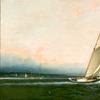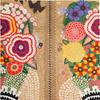Featured 19th Century Painter: Hugh Bolton Jones (American 1848 - 1927)
- March 15, 2021 07:31
Hugh Bolton Jones was born in Baltimore, Maryland and began his formal art studies in 1865, studying at the Maryland Institute (Maryland Institute College of Art) under portraitist, David Acheson Woodward and later in New York City with art designer Carey Smith and Hudson River School artist, Horace W. Robbins. In New York, Jones became friends with artist Thomas Hovenden and in 1868, he returned to Baltimore, accompanied by Hovenden, where they set up a studio together. Between 1865 and 1876 Jones split his between New York City and Baltimore. He had also purchased a cottage in South Egremont at the foot of the Berkshire Mountains in Massachusetts, where he summered. In the summer of 1870, he accompanied his family on a tour of Europe and in 1871, after his return, exhibited his landscape paintings of England and Ireland at the Baltimore Artists' Sale. Artist Hugh Bolton Jones took a break from his New York and Baltimore studios, when in the summer of 1873 he took advantage of railroad travel to traverse Maryland and Virginia making sketches. In 1876, Jones and his younger brother, Francis, also an artist, traveled to Europe. They stopped in London, England to visit American expatriate artist, Edwin Austin Abbey and then onto the art colony at Pont-Aven, Brittany, France for a year. Here they painted en plein air alongside Thomas Hovenden, another American expatriate artist and founding member of the colony, Robert Wylie, and William Picknell. By In 1877, after trips through Switzerland and Belgium, they were in Paris, France, where Francis enrolled at the Ecole des Beaux-Arts. After travel into Italy, Spain and Morocco, they returned to Paris where Francis enrolled in the Academie Julian. Hugh Jones returned to Baltimore in 1880 and then to New York where he opened a studio with Francis after his return in 1881. They shared the studio until his Hugh’s death in 1927. From 1883-1889 Jones painted at the summer art colony at Annisquam, Massachusetts, where he was reunited with his Pont-Aven friend, William Picknell. Prior to his trip to Europe and at Pont-Aven, Hugh Bolton Jones’s painting style was more akin to that of the Hudson River artists; after that he painted using quick brush strokes and lighting effects in the manner of the plein air impressionists, yet rendering the scene with traditional, academic precision. Circa 1890 Jones traveled to California to make sketches for use in preparing illustrations for Our Italy, a book on southern California by Charles Dudley Warner, published in 1891. In 1914 he became a trustee of the newly created Baltimore Museum of Art. Jones was a member of the Allston Association (1872); National Institute of Arts and Letters; Century Association; Charcoal Club; American Watercolor Society (1882); Painters in Watercolor; Boston Art Club; National Academy of Design (1881); National Arts Club, (New York); Pastel Society of America, Society of Painters in Pastel; Lotos Club; and Society of American Artists (1881). Jones exhibited at the National Academy of Design (1867-1927; Paris Salons (1877–81); Exposition Universelle (Paris, 1878); Pennsylvania Academy of the Fine Arts Annual (1879–85, 1891–1902, 1917–18), Boston Art Club (1881–1909); In 1884 Society of Painters in Pastels (1884); Art Institute of Chicago; Society of American Artists (1902); Corcoran Gallery of Art (Washington D.C., 1907–12); Grand Central Art Galleries (New York City); Vose Galleries (Boston, Massachusetts); Art Institute of Chicago; World's Columbian Exposition (Chicago, 1893, medal); Exposition Universelle (Paris, 1889, medal); Exposition Universelle (Paris, 1900, medal); Louisiana Purchase Exposition (St. Louis, 1904, medal); Panama–Pacific International Exposition (San Francisco, 1915, medal).











_-Closing-the-Distance_100x100_c.jpg)









